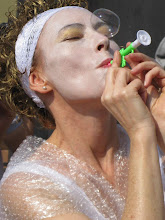
From the artist:
My talk info is here and I've pasted the info below as well. It will be Friday at 7pm on the 6th floor of the Fulbright Building, (168-15 Yomni-dong, Mapo-gu - English directions are on KAEC website at www.fulbright.or.kr ).
I know it says today (Tueday Apr 21) is the last day to RSVP, but I think it would be okay to RSVP later, or even just arrive. The RSVP is for a head count to make sure they get enough food. I doubt there will be a flood of unexpected guests b/c it looks like the weather will be rainy then. I'll be talking about my research on hanji (Korean handmade paper) and showing lots of photos and videos about making hanji and related crafts. I will also have a lot of "props" there - hanji and the like.
Aimee
Fulbright Forum
7:00 P.M. on Friday, April 24, 2009
R.S.V.P. by Tuesday, April 21
The Korean-American Educational Commission warmly welcomes you our fourth Fulbright Forum of the 2008-2009 program year with Fulbright Junior Researcher Aimee Lee.
"Spider Paths on the Paper Trail: Contemporary Possibilities for Hanji"
Open to all, the Fulbright Forum serves as a periodic gathering for the Fulbright Family at large, including past and present grantees and friends of Fulbright. Please reply to Nikki Guarino (executive.assistant@fulbright.or.kr) by Tuesday, April 21 to confirm your attendance. Regrets do not need to RSVP. This month's Forum will be held at 7:00 PM sharp on Friday, April 24 in the 6th floor conference room at the KAEC Building in Mapo-gu, Seoul, with a snack reception to follow in the 3rd floor administrative offices. Please visit the KAEC website at www.fulbright.or.kr for maps and directions.
To respect both the audience and presenters, late arrivals will not be allowed to enter after 7:05 PM.
Summary:
Hanji, Korean handmade paper, has a history on the peninsula that reaches back over one thousand years. With origins in China, papermaking spread to east to Korea and then Japan, speeding the use of written materials, contributing to literate and artistic cultures, nurturing religious traditions, and becoming part of daily life. Each culture developed similar but distinct methods of making long-fibered, strong paper from the mulberry tree. Through travel to various papermills, interviews with scholars, and study with artisans, Aimee has gained greater insight into the history of hanji, its glory days as the preferred paper in East Asia, and its demise with the rise of industrialization. She now seeks glimpses of its future: its role in conservation, the arts, and everyday life. Aimee will give a brief history of the craft, show photographs and videos of how hanji is made, as well as its presence in the contemporary art world, and use material demonstrations to exhibit related crafts, such as textured paper, twisting and weaving, and natural dyeing.
Biography:
Aimee Lee is a Junior Fulbright Researcher in Design and an interdisciplinary artist researching the current state of hanji, Korean handmade paper. As a papermaker, she has learned to make hanji from scratch at Jang Ji Bang, a 3rd- and 4th-generation family papermill in Gapyeong, and is currently studying with teachers of natural dyeing and paper weaving. She is affiliated FIDES International, where she is advised by B.K. Kim, and also advised by Professor Song Dae-Sup at Hongik University. She earned her MFA in Interdisciplinary Book and Paper Arts from Columbia College Chicago and her BA in Visual Arts from Oberlin College. She has performed extensively in the United States, exhibited internationally, and is now preparing two bodies of work for three solo exhibits in the fall of 2009. For more information, please visit http://aimeelee.net.

No comments:
Post a Comment